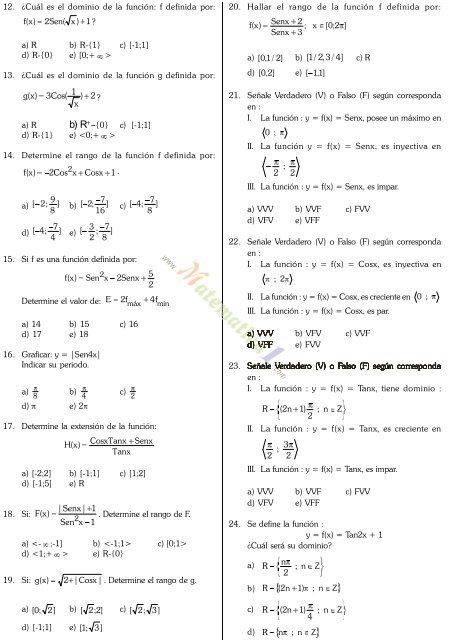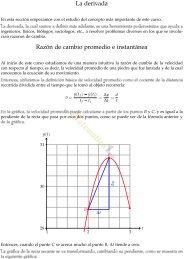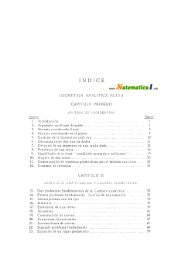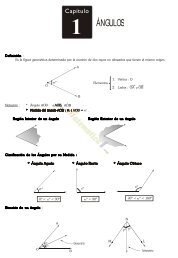libro de trigonometria preuniversitaria nivel uni click aqui para ver
libro de trigonometria preuniversitaria nivel uni click aqui para ver
libro de trigonometria preuniversitaria nivel uni click aqui para ver
You also want an ePaper? Increase the reach of your titles
YUMPU automatically turns print PDFs into web optimized ePapers that Google loves.
12. ¿Cuál es el dominio <strong>de</strong> la función: f <strong>de</strong>finida por:<br />
f ( x)<br />
2Sen(<br />
x ) 1 ?<br />
a) R b) R-{1} c) [-1;1]<br />
d) R-{0} e) [0;+ ><br />
13. ¿Cuál es el dominio <strong>de</strong> la función g <strong>de</strong>finida por:<br />
g ( x)<br />
3Cos(<br />
1<br />
) 2 ?<br />
x<br />
a) R b) R + {0} c) [-1;1]<br />
d) R-{1} e) <br />
14. Determine el rango <strong>de</strong> la función f <strong>de</strong>finida por:<br />
f(<br />
x)<br />
2<br />
2Cos<br />
x Cosx 1 .<br />
a) [ 2;<br />
9<br />
] b) [ 2;<br />
7<br />
] c) [ 4;<br />
7<br />
]<br />
8 16<br />
8<br />
d) [ 4;<br />
7<br />
] e) [<br />
3<br />
;<br />
7<br />
]<br />
4 2 8<br />
15. Si f es una función <strong>de</strong>finida por:<br />
f(<br />
x)<br />
Sen<br />
2<br />
x<br />
2Senx<br />
5<br />
2<br />
Determine el valor <strong>de</strong>: E 2f<br />
4f<br />
máx mín<br />
a) 14 b) 15 c) 16<br />
d) 17 e) 18<br />
16. Graficar: y = |Sen4x|<br />
Indicar su periodo.<br />
a)<br />
8<br />
b)<br />
4<br />
d) e) 2<br />
c) 2<br />
17. Determine la extensión <strong>de</strong> la función:<br />
18. Si:<br />
H(<br />
x)<br />
CosxTanx Senx<br />
Tanx<br />
a) [-2;2] b) [-1;1] c) [1;2]<br />
d) [-1;5] e) R<br />
F(<br />
x)<br />
| Senx|<br />
1<br />
. Determine el rango <strong>de</strong> F.<br />
2<br />
Sen x 1<br />
a) <br />
d) e) R-{0}<br />
19. Si: g ( x)<br />
2 | Cosx | . Determine el rango <strong>de</strong> g.<br />
a) [ 0;<br />
2]<br />
b) [ 2;<br />
2]<br />
c) [ 2;<br />
3]<br />
d) [-1;1] e) [ 1;<br />
3]<br />
20. Hallar el rango <strong>de</strong> la función f <strong>de</strong>finida por:<br />
f(<br />
x)<br />
Senx<br />
Senx<br />
2<br />
;<br />
3<br />
x<br />
[ 0;<br />
2<br />
a) [ 0,<br />
1 / 2]<br />
b) [ 1/<br />
2,<br />
3 / 4]<br />
c) R<br />
d) [ 0,<br />
2]<br />
e) [ 1,<br />
1]<br />
21. Señale Verda<strong>de</strong>ro (V) o Falso (F) según corresponda<br />
en :<br />
I. La función : y = f(x) = Senx, posee un máximo en<br />
0 ;<br />
]<br />
II. La función y = f(x) = Senx, es inyectiva en<br />
2<br />
;<br />
2<br />
III. La función : y = f(x) = Senx, es impar.<br />
a) VVV b) VVF c) FVV<br />
d) VFV e) VFF<br />
22. Señale Verda<strong>de</strong>ro (V) o Falso (F) según corresponda<br />
en :<br />
I. La función : y = f(x) = Cosx, es inyectiva en<br />
; 2<br />
II. La función : y = f(x) = Cosx, es creciente en 0 ;<br />
III. La función : y = f(x) = Cosx, es par.<br />
a) VVV b) VFV c) VVF<br />
d) VFF<br />
e) FVV<br />
23. Señale Verda<strong>de</strong>ro (V) o Falso (F) según corresponda<br />
en :<br />
I. La función : y = f(x) = Tanx, tiene dominio :<br />
R<br />
( 2n<br />
1)<br />
2<br />
; n<br />
Z<br />
II. La función : y = f(x) = Tanx, es creciente en<br />
2<br />
;<br />
3<br />
2<br />
III. La función : y = f(x) = Tanx, es impar.<br />
a) VVV b) VVF c) FVV<br />
d) VFV e) VFF<br />
24. Se <strong>de</strong>fine la función :<br />
y = f(x) = Tan2x + 1<br />
¿Cuál será su dominio?<br />
a) R<br />
n<br />
; n Z<br />
2<br />
b) R ( 2n<br />
1)<br />
; n Z<br />
c) R ( 2n<br />
1)<br />
; n Z<br />
4<br />
d) R n ; n Z







